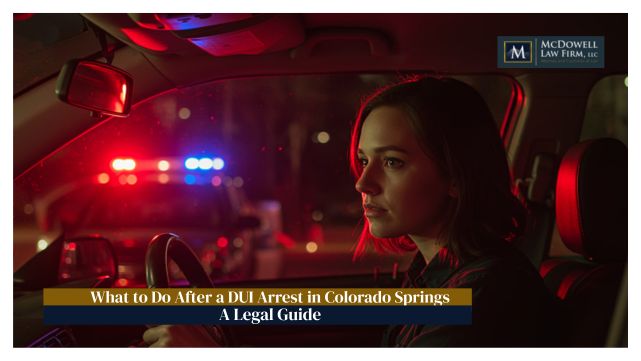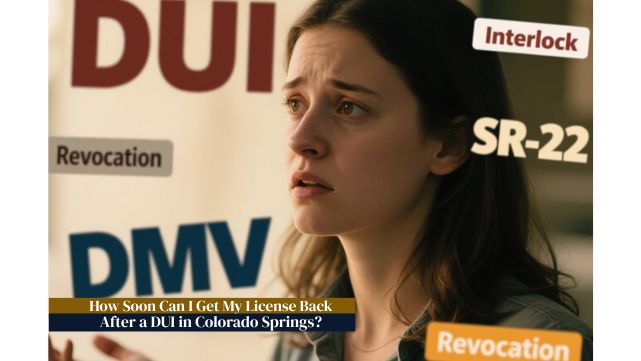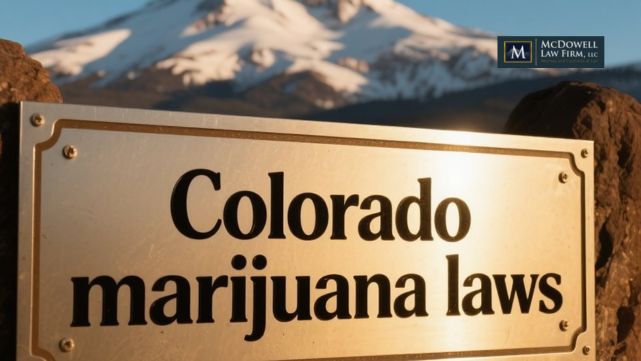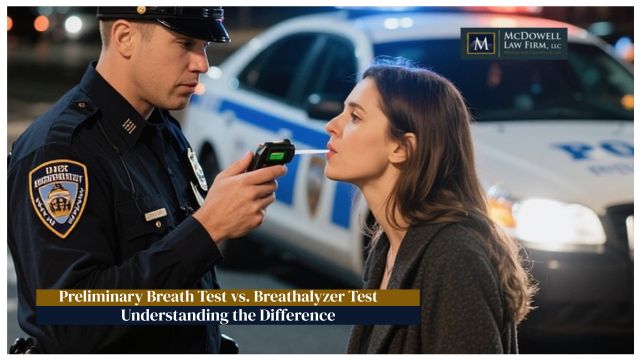Miranda rights are the familiar warnings given by police when taking a suspect into custody.
We’ve seen and heard it a million times on TV shows and movies when characters are being arrested. “You have the right to remain silent…”
These rights stem from U.S. Supreme Court rulings that protect two core constitutional guarantees: the Fifth Amendment privilege against self-incrimination and the Sixth Amendment right to counsel. In this overview, we’ll discuss the constitutional basis for Miranda rights, the required warning language, what counts as a “custodial interrogation,” key Supreme Court cases that shaped Miranda doctrine, how Colorado courts have applied these rules, and what happens if Miranda is violated.
Constitutional Basis of the Miranda Rights: The 5th and 6th Amendments
The Fifth Amendment to the U.S. Constitution provides that no person “shall be compelled in any criminal case to be a witness against himself,” establishing the right against self-incrimination. This means the government cannot force you to confess or incriminate yourself. Miranda rights are primarily a tool to safeguard this Fifth Amendment privilege during police interrogations. By contrast, the Sixth Amendment guarantees that in all criminal prosecutions, the accused has the right “to have the Assistance of Counsel for his defense.” Once formal charges are filed, a suspect has a Sixth Amendment right to an attorney during critical stages of the prosecution, including post-indictment interrogations.
Why is it called Miranda Rights?
In Miranda v. Arizona (1966), the Supreme Court drew on the Fifth Amendment, recognizing that custodial police interrogation is inherently coercive. To protect a suspect’s Fifth Amendment rights, the Court required police to inform suspects of certain rights (including the right to remain silent and to an attorney) before questioning. Notably, the warning’s mention of the right to an attorney is a prophylactic measure that also implicates the Sixth Amendment’s concern for counsel. In essence, the Miranda warnings meld the Fifth and Sixth Amendment principles: the right to remain silent (Fifth Amendment) and the right to counsel (Sixth Amendment) during interrogation, even before formal charges are brought, so that suspects can safely decide whether to speak.
The Supreme Court has described Miranda rules as “protective measures” to ensure the privilege against self-incrimination in the face of police pressure (see Densmore v. People & Frazee v. People (Amicus) | ACLU Colorado. If suspects know they can refuse to talk or can get a lawyer, they are less likely to be coerced into self-incrimination. Thus, while rooted in the Fifth Amendment, Miranda warnings also reflect the value of legal counsel (per the Sixth) as a buffer between a suspect and the state during questioning.
The Miranda Warning: Required Language
Most people can recite the Miranda warning from memory. Under Miranda v. Arizona, police must give a clear warning with several key components whenever a suspect is subjected to custodial interrogation. The required content (though not exact wording) of a Miranda warning is as follows:
- Right to Silence: You have the right to remain silent and refuse to answer questions.
- Consequences of Speaking: Anything you do say can (and will) be used against you in a court of law.
- Right to an Attorney: You have the right to consult an attorney before and during questioning.
- Appointment of Counsel: If you cannot afford an attorney, one will be appointed for you prior to any questioning if you so desire.
These four points are the crux of the Miranda warning. Law enforcement doesn’t have to quote them verbatim as long as the substance is conveyed. For example, the Supreme Court has upheld warnings that conveyed these rights in slightly different words, emphasizing that “no talismanic incantation” is required – just the essential information that a suspect can stay silent and request counsel.
The purpose of this scripted warning is to ensure the suspect is aware of their rights. A suspect can then make an informed choice: either waive the rights (agree to talk) or invoke them (stay silent or ask for a lawyer). Without such a warning, any statement the suspect makes is presumed compelled. In fact, statements made during a custodial interrogation without a proper Miranda advisement are generally inadmissible in the prosecution’s case-in-chief at trial (they cannot be used as direct evidence of guilt).
Custodial Interrogation: When Miranda Applies
Miranda rights are only required when a suspect is in custodial interrogation. This term has two components, both of which must be present: custody and interrogation.
- Custody: Not every interaction with police is “custody.” A person is in custody for Miranda purposes if they have been formally arrested or their freedom of movement is restrained to the degree associated with a formal arrest. The test is objective – would a reasonable person in that situation feel they were not free to leave? Key factors include the location of the encounter (stationhouse or public?), its length, whether officers used physical restraints or a commanding tone, whether the suspect was told they were free to leave, and the overall atmosphere (PEOPLE v. MATHENY (2002). No single factor is determinative; courts look at the totality of circumstances. For instance, a brief roadside stop is typically not custody (as in Berkemer v. McCarty, 468 U.S. 420 (1984)), but being locked in a police interrogation room likely is.
In a recent Colorado case, a woman was taken to a police station, had evidence bags zip-tied over her hands, and was questioned in a closed room. The Colorado Supreme Court held she was in custody under these conditions ( Colorado Supreme Court Holds Defendant Was in ‘Custody’ for Miranda Purposes Because She Had Hands Bagged and Zip Tied, Commanded Not to Remove Them, and Questioned Alone in Interrogation Room With Door Closed | Criminal Legal News ) – no reasonable person would feel free to leave when literally restrained and isolated. - Interrogation: Not every conversation is an interrogation. Under Rhode Island v. Innis (1980), “interrogation” includes express questioning or its functional equivalent ( Rhode Island v. Innis | 446 U.S. 291 (1980) ). In other words, police don’t have to directly ask “Did you commit the crime?” to interrogate – any words or actions by police (other than routine booking questions) that are reasonably likely to elicit an incriminating response count as interrogation (Rhode Island v. Innis | 446 U.S. 291 (1980)). This covers techniques like psychological pressure or guilt-tripping. For example, staging a conversation in front of a suspect about how terrible the crime was might elicit a blurted confession; the Court would consider that the “functional equivalent” of questioning. On the other hand, voluntary statements not prompted by police (a suspect who just starts talking on their own) are not interrogation, nor are basic identifying questions normally attendant to arrest (name, date of birth, etc.).
Putting it together: Miranda warnings are required only when a person is both in custody and is being interrogated by law enforcement. If an individual is not in custody (e.g. they came to the station voluntarily and can leave), or if they are not being interrogated (e.g. they are just chatting about unrelated matters), Miranda doesn’t apply. Once both conditions are met, however, police must advise the rights. If they fail to and still obtain a statement, that statement is generally excluded at trial because it was obtained in violation of the suspect’s Fifth Amendment privilege.
One nuance is that traffic stops and Terry stops (brief investigative detentions) are usually not considered custody for Miranda purposes, because they are temporary and less coercive than a stationhouse interrogation. Additionally, prison inmates aren’t automatically “in custody” for Miranda just by virtue of imprisonment. The Supreme Court in Howes v. Fields, 565 U.S. 499 (2012), held that questioning an inmate about a separate crime may not be custody if the setting and freedom to end the interview are such that a reasonable person would feel free to terminate the questioning. The inquiry is always: would a reasonable person feel significantly deprived of freedom? If yes, and police interrogation is underway, Miranda must be given.
Landmark U.S. Supreme Court Cases Shaping Miranda Doctrine
Miranda rights originated and evolved through several major Supreme Court decisions. Here are some of the key cases and what they established:
- Miranda v. Arizona (1966): This is the foundational case that created the Miranda warnings. The Court held that before any custodial interrogation, law enforcement must advise a suspect of the now-familiar rights (to silence and counsel) to protect the Fifth Amendment. Ernesto Miranda’s own conviction was overturned because he had confessed without being informed of his rights. Miranda revolutionized police procedure nationwide.
- Michigan v. Mosley (1975): Clarified the right to remain silent. If a suspect invokes the right to silence, the interrogation must “scrupulously honor” that invocation – meaning police must stop questioning. However, Mosley allows police to re-initiate questioning later on a different topic or after a substantial break, provided fresh warnings are given. The idea is that the right to cut off questioning must be respected, but it doesn’t permanently prohibit all future questioning in every context.
- Edwards v. Arizona (1981): Established a bright-line rule for the right to counsel. If a suspect invokes the right to an attorney, all interrogation must cease until an attorney is present. Police cannot simply come back an hour later and try again without a lawyer. The suspect cannot be questioned further unless they initiate the conversation themselves or a lawyer is actually with them. This is a strong protection (often called the Edwards rule) meant to prevent police from badgering a suspect into waiving the already-invoked right to counsel.
- Illinois v. Perkins (1990): An interesting exception – Miranda warnings are not required when the suspect is unaware they are speaking to law enforcement (e.g. an undercover agent posing as a fellow inmate). Because the coercive pressure is absent (the suspect doesn’t know it’s an interrogation by police), the Court held that statements to undercover officers are admissible without warnings. This case underscores that the custodial setting triggering Miranda assumes the suspect knows they are dealing with the authorities.
- Dickerson v. United States (2000): Reaffirmed Miranda as a constitutional rule. Congress had passed 18 U.S.C. § 3501 to try to overrule Miranda by allowing voluntariness alone to determine admissibility of confessions. In Dickerson, the Supreme Court struck down that statute, holding that Miranda is a constitutional decision that Congress cannot override (DICKERSON V. UNITED STATES). The Court made clear that Miranda warnings are required in both state and federal cases as a matter of constitutional law. This settled any doubt that Miranda was merely a court-made prophylactic rule with no constitutional footing – Miranda “cannot be in effect overruled by an Act of Congress”
- Missouri v. Seibert (2004): Addressed a police tactic of “question-first, warn later.” Officers in Seibert deliberately interrogated a suspect without Miranda until she confessed, then gave the Miranda warning, and had her repeat the confession. The Supreme Court condemned this end-run around Miranda, ruling that a post-warning confession must be suppressed if a prior unwarned confession was obtained as part of a strategy to undermine Miranda. The plurality looked at factors like the completeness and detail of the first confession, the timing and setting, and whether it seemed like one continuous interrogation. Seibert contrasted with Oregon v. Elstad (1985), where an initial unwarned admission (made without police coercion or intent to undermine Miranda) did not taint a second, warned confession. The takeaway: police cannot intentionally withhold warnings to get a confession, then “cure” it by warning after the fact – that subverts the Miranda rule.
- Berghuis v. Thompkins (2010): Refined the rules on invoking or waiving rights. The Court held that remaining silent is not enough to invoke the right to remain silent; a suspect must clearly assert their right for questioning to cease (Berghuis v. Thompkins – Wikipedia). In Thompkins, the suspect was mostly silent for nearly three hours and never affirmatively said he wanted to remain silent or wanted a lawyer. He eventually answered a question. The Court treated that single answer as an implied waiver of his Miranda rights. In short, if a suspect talks at all after hearing the warnings, courts may deem the rights waived unless the suspect had expressly invoked the right to cut off questioning. This case puts the onus on suspects to unambiguously invoke their rights; otherwise, police can continue to gently prompt, and any voluntary statement will likely be admissible.
- Maryland v. Shatzer (2010): Modified the Edwards rule for right-to-counsel invocations. Shatzer held that if a suspect invokes counsel and is released from Miranda custody, police must wait at least 14 days after release before re-initiating interrogation. After that break in custody, the Edwards protection expires, and the suspect can be approached again with fresh warnings. This gives a practical endpoint to Edwards in scenarios like prison inmates (Shatzer himself was in prison for a different crime when questioned).
- J.D.B. v. North Carolina (2011): Addressed how age affects the custody analysis. The Court said that when determining if a juvenile was in custody (the reasonable person test), the suspect’s age (if known or apparent to officers) is relevant. A child might not feel free to leave where an adult would. This was a significant development for juvenile justice, ensuring that courts consider a young suspect’s perspective in deciding if Miranda warnings were required.
- Salinas v. Texas (2013): Although not a custodial case, it’s worth noting: the Court held that a suspect who is not in custody and volunteers answers cannot simply refuse to answer one incriminating question and later claim Fifth Amendment privilege – to benefit from the privilege in a non-custodial setting, one must expressly invoke it. This case underscored how Miranda’s procedural protections (which apply only in custody) simplify things; outside custody, navigating the Fifth Amendment can be trickier for a suspect.
- Vega v. Tekoh (2022): A recent case highlighting Miranda’s legal nature. The Supreme Court ruled that a failure to give Miranda warnings does not, by itself, give rise to a civil lawsuit for money damages under 42 U.S.C. §1983. In other words, Miranda rights are a constitutional rule for excluding evidence, but they do not create an independent cause of action against police. The Court reasoned that the Miranda rule is a prophylactic safeguard and not an absolute constitutional right in itself such that every violation would allow a lawsuit. This 2022 decision stirred discussion in legal circles (and dissent from some Justices), but it reaffirms that the main consequence of a Miranda violation is exclusion of evidence, not civil liability.
Each of these cases contributes to the Miranda doctrine of today. Together, they illustrate the balance courts strike between effective law enforcement questioning and the protection of suspects’ constitutional rights. Miranda rights have proven to be a nuanced area where bright-line rules (like Edwards’ no re-interrogation after counsel request) coexist with case-by-case judgments (like what counts as custody or a valid waiver).
Miranda in Colorado: State Cases and Interpretations
State courts, including Colorado’s, apply the federal Miranda rule and sometimes extend additional protections under state law. Colorado’s courts have grappled with what “custody” means and how strictly to enforce Miranda in various scenarios. The Colorado Supreme Court has generally aligned with U.S. Supreme Court precedent, while interpreting the facts of each case using the Miranda standards.
Custody factors in Colorado: The Colorado Supreme Court set out a non-exhaustive list of factors to determine custody in People v. Matheny, 46 P.3d 453 (Colo. 2002). These factors mirror the federal reasonable-person test and include: the time, place, and purpose of the encounter; the number of officers present; the officer’s words and demeanor; the length and mood of the interrogation; any physical restraint or limitation of movement; whether the suspect was told they were free to leave; and the suspect’s reactions to the interrogation. No one factor rules the outcome – they are weighed in totality (PEOPLE v. MATHENY (2002) | FindLaw). Colorado courts often cite these “Matheny factors” in deciding if a defendant was in custody (and thus entitled to Miranda warnings).
For example, in People v. Niemeyer, 2024 CO 58, the Colorado Supreme Court applied these factors and concluded that Niemeyer was in custody during her police station questioning. Niemeyer had not been formally arrested, but police had transported her from a crime scene to the station, kept her in an interview room with the door closed, and even placed bags over her hands to preserve gunshot evidence. She repeatedly asked to go to the hospital to see her husband (the shooting victim) but was told “we have to do this first.” Despite being told at one point that she was not under arrest, the court found that a reasonable person in her position would certainly feel they were not free to leave. The restraints and control exercised by police (like the bagged hands) tipped the balance toward custody. Consequently, because she was interrogated without a Miranda advisement in that setting, her statements had to be suppressed.
Colorado courts have also addressed Miranda invocation issues. In People v. Cerda, 2024 CO 49, the suspect was Mirandized and initially agreed to talk. But during the interrogation, Mr. Cerda changed his mind and clearly said he wanted to remain silent. Detectives ignored this and continued questioning him. The Colorado Supreme Court held that this violated Miranda – when a suspect “clearly and unambiguously invoked his right to remain silent,” the interrogation must stop (People v. Cerda. | Colorado Lawyer). The Court affirmed suppression of Cerda’s statements made after he invoked silence, meaning those statements could not be used by the prosecution in its case-in-chief (People v. Cerda. | Colorado Lawyer). However, the Court also examined whether the continued questioning produced an involuntary confession or merely a technical Miranda violation. It found that although the officers violated Miranda, Cerda’s will was not overborne – the statements were voluntary under the broader due process test. This nuance mattered because a voluntary statement obtained in violation of Miranda is excluded from the prosecution’s main case, but it could potentially be used for impeachment (to challenge the defendant’s testimony) or lead to other evidence, whereas an involuntary statement would be entirely inadmissible for any purpose. The Cerda decision thus reinforces both the requirement to “scrupulously honor” a suspect’s invocation and the distinction between a mere Miranda violation and a coerced confession.
Another notable Colorado case is People v. Sanders, 2023 CO 62, which involved an alleged child assault. The trial court suppressed the defendant’s statements for being elicited during a custodial interrogation without warnings, and also found the statements involuntary. The Colorado Supreme Court ultimately upheld the suppression. Importantly, because the prosecution failed to challenge the voluntariness ruling on appeal, the Supreme Court noted it would affirm the suppression even if it disagreed about custody ( People v. Sanders :: 2023 :: Colorado Supreme Court Decisions :: Colorado Case Law :: Colorado Law :: U.S. Law :: Justia). Sanders serves as a practical reminder: a statement taken without Miranda might be suppressed on multiple grounds (Miranda and involuntariness), and on appeal the prosecution must overcome all grounds to get it admitted. Sanders illustrates how Miranda violations interplay with the fundamental requirement that confessions be voluntary, and how appellate procedure can solidify a suppression result.
Colorado has also considered unique scenarios, such as whether a social services investigator questioning a suspect in jail must Mirandize (as raised in People v. Frazee, 2022). While the law is still developing, it shows Colorado’s willingness to examine Miranda’s reach beyond traditional police interrogators. In general, Colorado law hews to the federal baseline: Article II, Section 18 of the Colorado Constitution mirrors the Fifth Amendment, so Colorado courts usually apply Miranda as a matter of state law in lockstep with federal interpretations. There is no significant divergence that gives suspects greater Miranda rights in Colorado than under federal law (unlike some states that have, for instance, required counsel for juveniles or stricter waiver standards). Thus, federal precedent remains key, with Colorado cases providing illustrative applications on local facts.
Consequences of Miranda Violations: Suppression and Other Remedies
What happens if police fail to give a Miranda warning, or violate a suspect’s Miranda rights by ignoring an invocation?
The primary consequence is the exclusion of the suspect’s statements at trial.
The prosecution generally cannot use a statement obtained in violation of Miranda during its case-in-chief (the main trial to prove guilt). This exclusionary rule is meant to remove the incentive for police to bypass Miranda – if they do, the confession likely gets thrown out and cannot directly help convict the defendant.
For example, if a suspect confesses during an unwarned custodial interrogation, the defense will file a motion to suppress that confession. If the court agrees a Miranda violation occurred, the confession (and any self-incriminating statements) will be suppressed. This can be outcome-determinative for a case: many prosecutions rely heavily on a confession, so losing it may force the state to drop charges or accept a plea to a lesser offense. Even if the case isn’t completely dependent on the confession, the jury will never hear that damaging statement, which can significantly improve the defendant’s chances.
In Miranda v. Arizona itself, Miranda’s unwarned confession was tossed, and while he was later retried and convicted with other evidence, the ruling set the precedent that such statements are inadmissible. In our earlier Colorado example, Rachel Niemeyer’s statements (made while effectively in custody without warning) were ordered suppressed. See Colorado Supreme Court Holds Defendant Was in ‘Custody’ for Miranda Purposes Because She Had Hands Bagged and Zip Tied, Commanded Not to Remove Them, and Questioned Alone in Interrogation Room With Door Closed | Criminal Legal News ), which would greatly weaken any prosecution against her since her own words about the incident couldn’t be used to incriminate her.
Exceptions of the use of Miranda Rights
There are some limits and exceptions regarding the use of statements obtained in violation of Miranda:
- Impeachment Use: If a defendant chooses to testify at trial, an otherwise inadmissible statement (taken in violation of Miranda) can sometimes be used to impeach the defendant’s credibility. The U.S. Supreme Court in Harris v. New York, 401 U.S. 222 (1971), allowed this use, reasoning that Miranda shouldn’t be a license to commit perjury. For instance, if a defendant testifies, “I never said I was at the crime scene,” a prior unwarned admission to being at the scene could be introduced to contradict (impeach) that testimony. However, coerced involuntary confessions (which violate the Fifth Amendment outright) cannot be used even for impeachment. The statement must have been voluntary in the sense that it wasn’t the product of torture or coercion, even if Miranda wasn’t followed.
- Derivative Evidence (“Fruit of the Poisonous Tree”): A tricky issue is whether evidence derived from a Miranda-violative statement must be excluded. For example, suppose a suspect, without being Mirandized, reveals the location of a weapon, and police retrieve the weapon based on that statement. Can the weapon be used in court? The Supreme Court addressed this in United States v. Patane, 542 U.S. 630 (2004), and drew a distinction. The physical evidence (the gun) obtained from an unwarned but voluntary statement need not be suppressed (UNITED STATES V. PATANE – Cornell University). The rationale is that the Fifth Amendment protects against compelled testimony, not the introduction of physical evidence. So, failing to give Miranda warnings does not require excluding the physical fruit of a suspect’s unwarned words (UNITED STATES V. PATANE – Cornell University), as long as those words were not coerced. By contrast, if the statement was actually coerced (involuntary), then both the statement and its fruits are inadmissible, because using them would violate due process. In practice, most courts do not suppress physical evidence or the testimony of new witnesses just because they were found via a Miranda technical violation (they would if the confession was coerced, though). This is an important caveat: Miranda’s exclusionary rule is strong but not absolute – it focuses on keeping the unwarned statements themselves out of the prosecution’s direct case.
- Public Safety Exception: One notable exception (not exactly a remedy, but a carve-out) is the New York v. Quarles, 467 U.S. 649 (1984) public safety exception. If police questions are prompted by an immediate concern for safety (e.g. “Where is the gun?” in a volatile scene) and not for obtaining testimonial evidence, the suspect’s answers may be admissible despite no warnings. The reasoning is that protecting the public from imminent danger outweighs the need for a Miranda warning in that moment. The response can be used in court, even though normally it would violate Miranda. This exception is narrow but has been applied in cases of potential bombs, hidden weapons, etc., and attorneys should be aware of it as a pragmatic limit on Miranda’s reach.
In terms of remedies for violations: the core remedy is exclusion of the statement (and possibly any truly tainted evidence flowing from an actual Fifth Amendment violation). Courts do not impose other sanctions on police in the context of a criminal trial if Miranda is violated – the jury simply never hears the evidence. As mentioned, suspects cannot sue officers just for a Miranda violation after the Supreme Court’s Vega v. Tekoh decision in 2022, so exclusion remains the primary remedy. Sometimes, if a statement is central and gets suppressed, the prosecution might offer a better plea deal or even dismiss charges for lack of evidence. In some cases, a Miranda violation might not ultimately change the trial outcome if there is ample other evidence of guilt, but it removes one piece of the puzzle from the state’s case.
To illustrate the impact: In People v. Sanders (Colo. 2023), after Sanders’ statements were suppressed due to a Miranda violation, the prosecution had to proceed without that confession. Had those statements been admitted, they likely would have strongly supported the charges of sexual assault on a child. Without them, the state’s case had to rely on other evidence, which may be considerably weaker. Thus, a Miranda suppression can transform the dynamics of a case. This is why police officers take care to Mirandize suspects when required – an oversight can jeopardize the entire case.
Finally, it’s crucial to note that Miranda violations do not automatically free a suspect or nullify an arrest. The violation only concerns whether a statement (or confession) can be used as evidence. If police have other evidence (for example, physical evidence or eyewitnesses), a prosecution can still proceed.
I’m often asked by clients: “Can my charges be dropped because they didn’t read me my rights?” My answer: Unlikely to be dropped/dismissed. But it might help our case at trial or in plea bargaining.
The remedy is exclusion of the statement, not a get-out-of-jail-free card. Only if the statement was essential to the case would its exclusion likely lead to a dismissal.
Conclusion
Miranda rights remain a cornerstone of criminal procedure, encapsulating the spirit of the Fifth and Sixth Amendments in a few sentences recited by police daily. The Miranda doctrine offers a rich study in how constitutional principles are implemented through practical rules. We see the law wrestling with real-world scenarios: the pressured atmosphere of interrogations, the wily tactics of investigators, and the need to protect individual dignity and free choice. From Miranda in 1966 to the present, courts have refined these rules – requiring warnings, defining custody and interrogation, policing the line between a valid waiver and a coerced confession, and enforcing the consequences when police mess up.
Do Miranda warnings actually prevent coercion, or have police simply adapted their strategies?
While not perfect, Miranda has become an ingrained safeguard. It forces police to pause and inform, and it gives suspects a clear signal of their rights. The doctrine continues to evolve (as recent cases like Thompkins and Tekoh show). Miranda rights are not just a perfunctory recital – they are a constitutional promise that the justice system will not steamroll individuals without giving them a chance to exercise their fundamental rights. In the dance between law enforcement and individual liberties, Miranda remains a crucial step, ensuring the words “you have the right to remain silent” carry real weight in protecting those in the custody of the state.
Sources: Miranda v. Arizona, 384 U.S. 436 (1966); Dickerson v. United States, 530 U.S. 428 (2000); Berghuis v. Thompkins, 560 U.S. 370 (2010); Edwards v. Arizona, 451 U.S. 477 (1981); Rhode Island v. Innis, 446 U.S. 291 (1980); People v. Niemeyer, 2024 CO 58; People v. Cerda, 2024 CO 49; People v. Sanders, 2023 CO 62; and other cases and materials as cited above. () () ( Rhode Island v. Innis | 446 U.S. 291 (1980) | Justia U.S. Supreme Court Center) ( Colorado Supreme Court Holds Defendant Was in ‘Custody’ for Miranda Purposes Because She Had Hands Bagged and Zip Tied, Commanded Not to Remove Them, and Questioned Alone in Interrogation Room With Door Closed | Criminal Legal News ) (People v. Cerda. | Colorado Lawyer) (People v. Cerda. | Colorado Lawyer) (Takeaways for police of SCOTUS decision on Miranda) (UNITED STATES V. PATANE – Cornell University)






